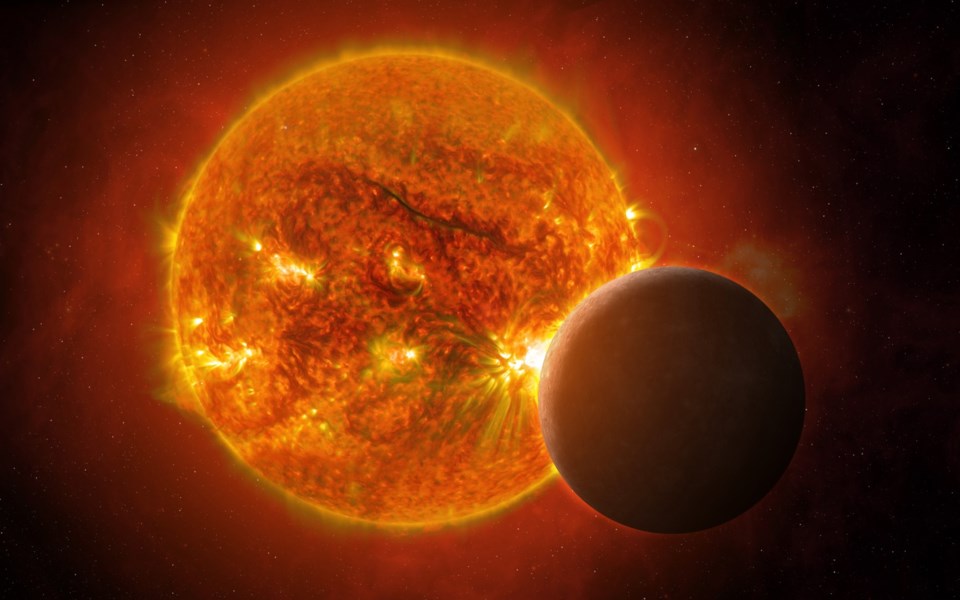The moon is at apogee in the 1st, the furthest distance from Earth in its monthly orbit at 404,909 kilometres. Coincidentally, Earth in its annual orbit is at its closest point to the sun Jan. 2, at perihelion of 147,100,632 km. Jan. 3, our satellite is at last quarter. Spica is two degrees south of the moon Jan. 4. Antares, the bright star in Scorpius, is occulted on the morning of Jan. 8, visible to most of North America – a reason to get up early. Also on that day, Venus is visible six degrees north of the moon. Just before new moon on Jan. 11th, Mars is four degrees north Jan. 10t and perigee, the closest the moon is to the Earth, is reached Jan. 13th. Saturn is two degrees north of the lunar thin sliver Jan. 14. Neptune is less than a degree away from the waxing crescent moon on the morning of Jan.15 for telescopic viewers. First quarter is achieved Jan. 17. Jupiter, Uranus and the Pleiades are close by Jan. 18, 19 and 20, respectively. Just before full moon Jan. 25, Pollux is less than two degrees south on Jan. 24. Once again, after completing a full orbit, the moon is at apogee Jan. 29 at 405,777 kilometres.
Mercury is a morning object at the beginning of the year, just far enough away from the sun to be visible. It reaches its greatest elongation west Jan. 12. As it gradually circles in its orbit, Mercury gains in brightness, becoming more and more lit by the sun, until it becomes too close to be visible.
Venus is the Morning Star in January twilight, six degrees north of the moon on Jan. 8. The bright planet puts on a better show for viewers in the С����Ƶern Hemisphere as the angle of the ecliptic hugs the horizon for northern observers.
Mars is a morning object for all of 2024. The Red Planet is four degrees north of the moon on Jan. 10. Early risers might catch Mercury 0.2 degrees from Mars Jan. 27.
Jupiter has been retrograding among the stars of Aries and begins eastward prograde motion in the eastern evening sky as the years opens. Double shadows from Jupiter’s moons are visible Jan. 6. The first-quarter moon glides by Jan. 18.
Saturn, С����Ƶ so far away from Earth, remains stuck in the constellation Aquarius all year, briefly visible in the evening sky just after sunset. The waxing crescent moon passes by the Ringed Planet Jan. 14. Speaking of the rings, they appear narrower and narrower as the year progresses. At the end of the month, Saturn is too close to the sun for viewing. When it reappears in March mornings, the shallow ecliptic hinders observing for northern viewers.
Uranus has been retrograding and gradually appears stationary among the stars of Aries on Jan. 27, slowly beginning prograde, or eastward, motion.
Neptune requires optical aid to find it in the constellation Pisces, the fish. The Blue Planet is occulted for С����Ƶern Hemisphere observers Jan. 15 – a close approach of 0.9 degrees for northern viewers.
The Quadrantid meteors peak on Jan. 4 at 9 UT (3 a.m. CST).
James Edgar has had an interest in the night sky all his life. He joined the Royal Astronomical Society of Canada in 2000, was national president for two terms, is now the editor of the Observer’s Handbook and production manager of the bi-monthly RASC Journal. The IAU named asteroid 1995 XC5 “(22421) Jamesedgar” in his honour and he was recently awarded a Fellowship of the RASC.
Keep your news a touch away by bookmarking The News-Optimist homepage at this link.



